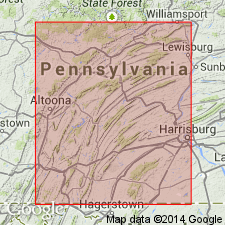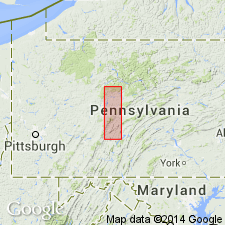
- Usage in publication:
-
- Clover member
- Modifications:
-
- Named
- Dominant lithology:
-
- Limestone
- AAPG geologic province:
-
- Appalachian basin
Summary:
Named for Clover Creek, east of Williamsburg, Blair Co., PA. Type section is Pennsylvania Railroad cut, Union Furnace, Huntingdon Co., PA. Consists of principally dense, white-weathering, sublithographic limestone, somewhat magnesian. 50-80 feet thick. Overlies "tiger-stripped" lithology of Loysburg formation; underlies Hatter formation. Age is Middle Ordovician. Publication includes stratigraphic column and map of outcrop areas.
Source: GNU records (USGS DDS-6; Reston GNULEX).

- Usage in publication:
-
- Clover limestone
- Modifications:
-
- Revised
- AAPG geologic province:
-
- Appalachian basin
Summary:
Revised to Clover limestone of Loysburg Group. Overlies "Tiger-striped" limestone; underlies Hatter limestone. Approximately 80 feet thick. Includes stratigraphic column.
Source: GNU records (USGS DDS-6; Reston GNULEX).
For more information, please contact Nancy Stamm, Geologic Names Committee Secretary.
Asterisk (*) indicates published by U.S. Geological Survey authors.
"No current usage" (†) implies that a name has been abandoned or has fallen into disuse. Former usage and, if known, replacement name given in parentheses ( ).
Slash (/) indicates name conflicts with nomenclatural guidelines (CSN, 1933; ACSN, 1961, 1970; NACSN, 1983, 2005, 2021). May be explained within brackets ([ ]).

